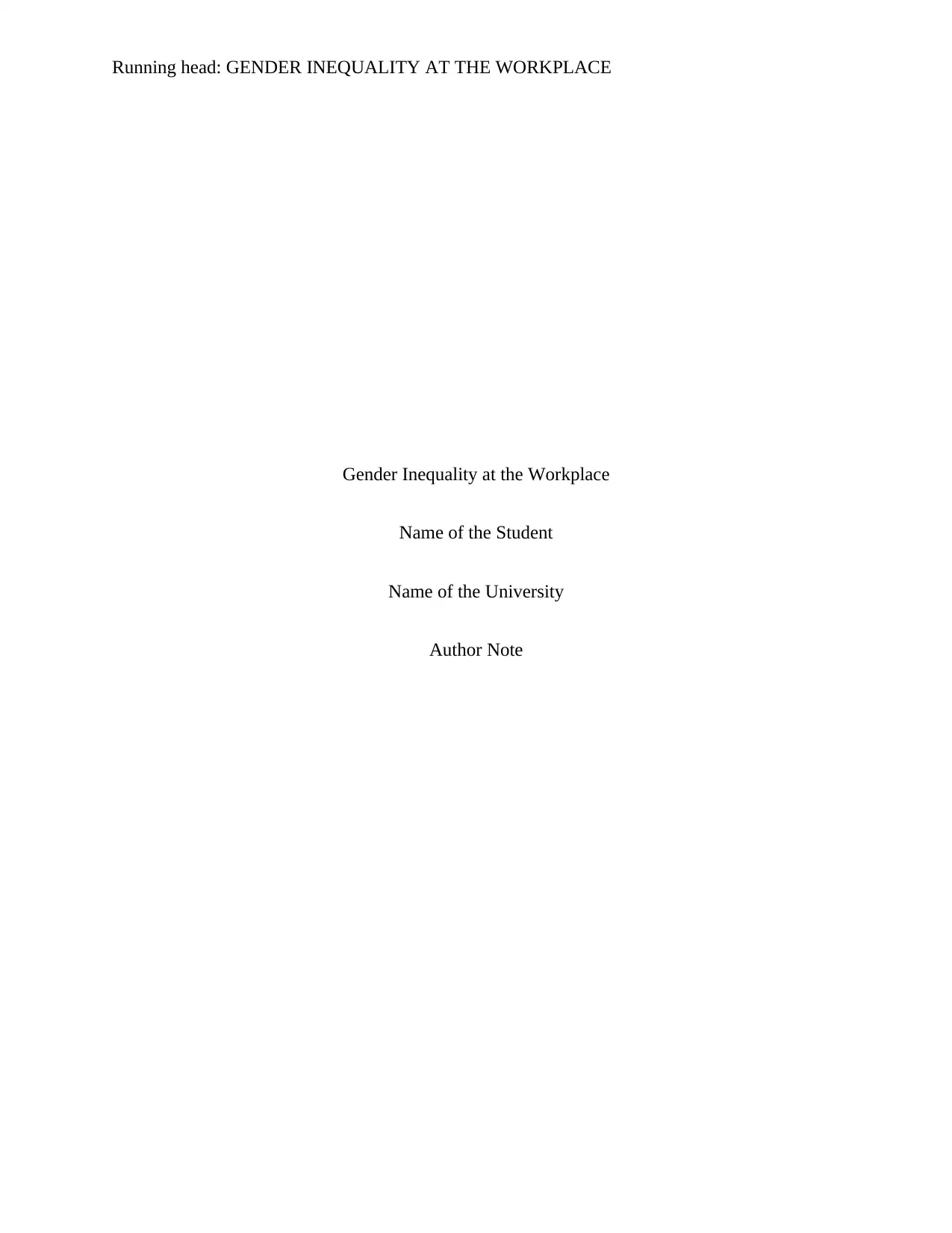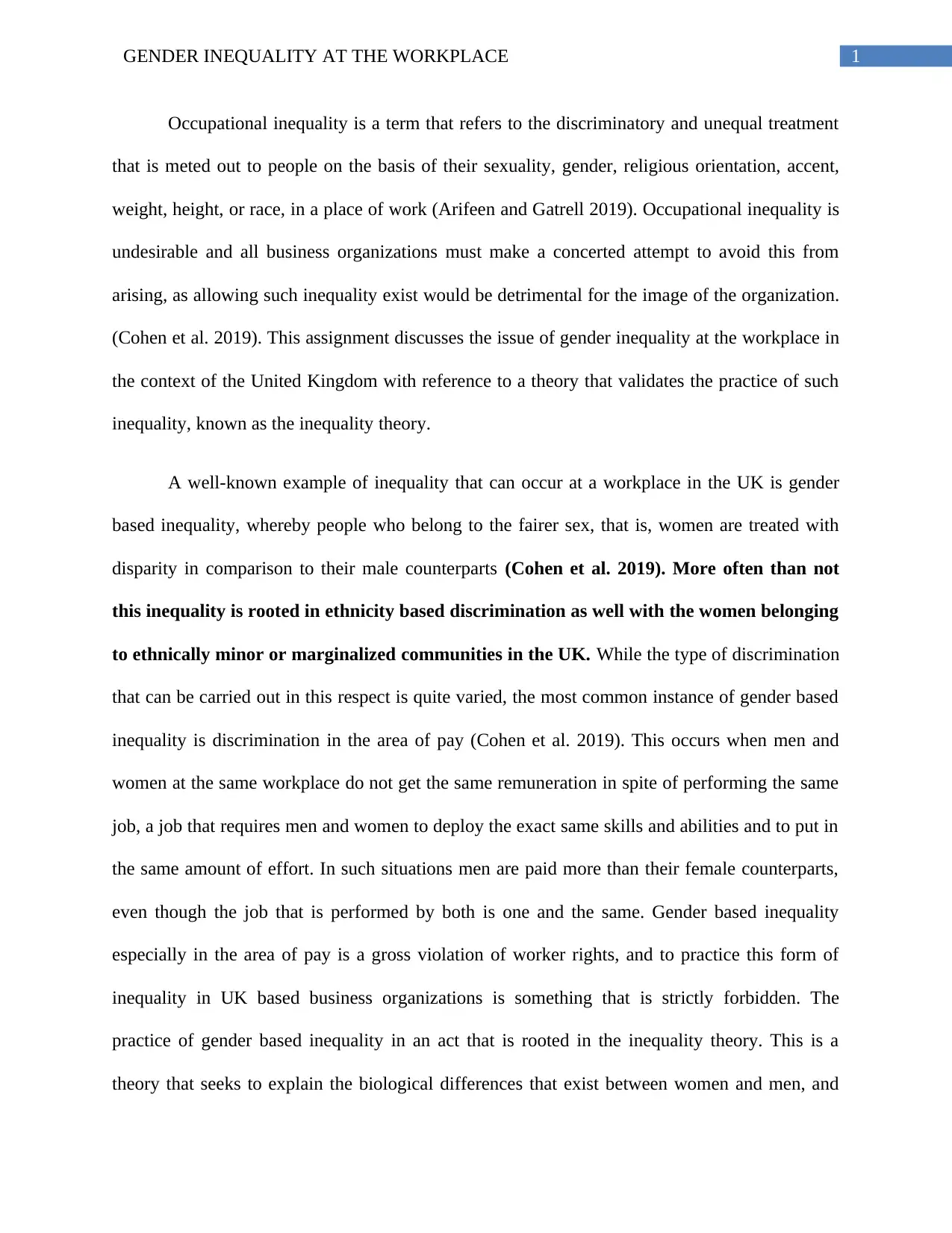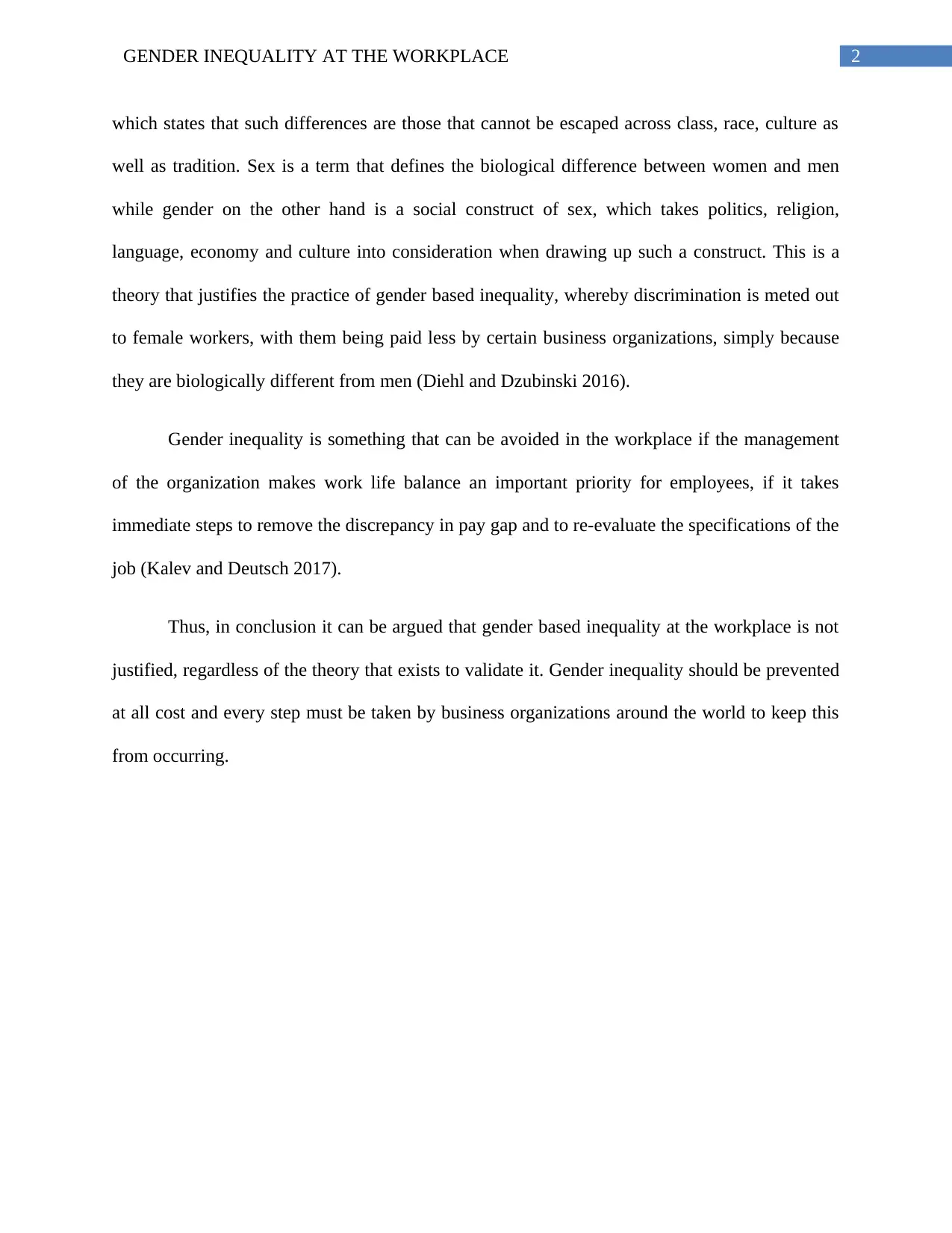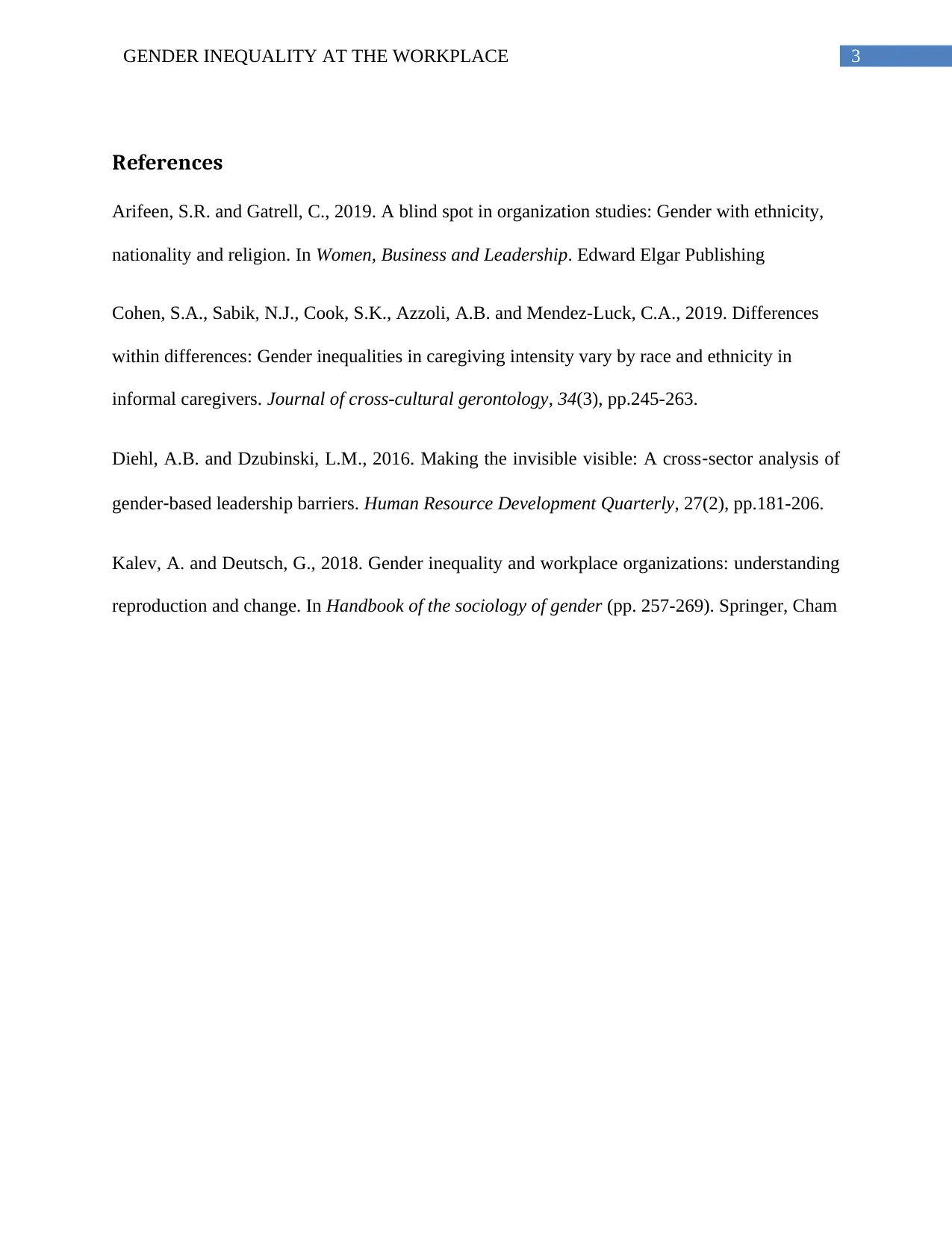Gender Inequality at the Workplace: UK Case Study Analysis
VerifiedAdded on 2022/08/08
|4
|820
|32
Essay
AI Summary
This essay examines gender inequality in the UK workplace, focusing on pay disparities and discriminatory practices. It explores the concept of occupational inequality and how it manifests in gender-based discrimination, often exacerbated by ethnicity. The assignment highlights the prevalence of unequal pay for men and women performing the same jobs, violating worker rights. It delves into the inequality theory, which attempts to justify these differences based on biological distinctions, and argues against its validity. The essay emphasizes the importance of work-life balance, eliminating pay gaps, and re-evaluating job specifications to prevent gender inequality. It concludes that regardless of theoretical justifications, gender inequality should be actively prevented in all business organizations.

Running head: GENDER INEQUALITY AT THE WORKPLACE
Gender Inequality at the Workplace
Name of the Student
Name of the University
Author Note
Gender Inequality at the Workplace
Name of the Student
Name of the University
Author Note
Paraphrase This Document
Need a fresh take? Get an instant paraphrase of this document with our AI Paraphraser

1GENDER INEQUALITY AT THE WORKPLACE
Occupational inequality is a term that refers to the discriminatory and unequal treatment
that is meted out to people on the basis of their sexuality, gender, religious orientation, accent,
weight, height, or race, in a place of work (Arifeen and Gatrell 2019). Occupational inequality is
undesirable and all business organizations must make a concerted attempt to avoid this from
arising, as allowing such inequality exist would be detrimental for the image of the organization.
(Cohen et al. 2019). This assignment discusses the issue of gender inequality at the workplace in
the context of the United Kingdom with reference to a theory that validates the practice of such
inequality, known as the inequality theory.
A well-known example of inequality that can occur at a workplace in the UK is gender
based inequality, whereby people who belong to the fairer sex, that is, women are treated with
disparity in comparison to their male counterparts (Cohen et al. 2019). More often than not
this inequality is rooted in ethnicity based discrimination as well with the women belonging
to ethnically minor or marginalized communities in the UK. While the type of discrimination
that can be carried out in this respect is quite varied, the most common instance of gender based
inequality is discrimination in the area of pay (Cohen et al. 2019). This occurs when men and
women at the same workplace do not get the same remuneration in spite of performing the same
job, a job that requires men and women to deploy the exact same skills and abilities and to put in
the same amount of effort. In such situations men are paid more than their female counterparts,
even though the job that is performed by both is one and the same. Gender based inequality
especially in the area of pay is a gross violation of worker rights, and to practice this form of
inequality in UK based business organizations is something that is strictly forbidden. The
practice of gender based inequality in an act that is rooted in the inequality theory. This is a
theory that seeks to explain the biological differences that exist between women and men, and
Occupational inequality is a term that refers to the discriminatory and unequal treatment
that is meted out to people on the basis of their sexuality, gender, religious orientation, accent,
weight, height, or race, in a place of work (Arifeen and Gatrell 2019). Occupational inequality is
undesirable and all business organizations must make a concerted attempt to avoid this from
arising, as allowing such inequality exist would be detrimental for the image of the organization.
(Cohen et al. 2019). This assignment discusses the issue of gender inequality at the workplace in
the context of the United Kingdom with reference to a theory that validates the practice of such
inequality, known as the inequality theory.
A well-known example of inequality that can occur at a workplace in the UK is gender
based inequality, whereby people who belong to the fairer sex, that is, women are treated with
disparity in comparison to their male counterparts (Cohen et al. 2019). More often than not
this inequality is rooted in ethnicity based discrimination as well with the women belonging
to ethnically minor or marginalized communities in the UK. While the type of discrimination
that can be carried out in this respect is quite varied, the most common instance of gender based
inequality is discrimination in the area of pay (Cohen et al. 2019). This occurs when men and
women at the same workplace do not get the same remuneration in spite of performing the same
job, a job that requires men and women to deploy the exact same skills and abilities and to put in
the same amount of effort. In such situations men are paid more than their female counterparts,
even though the job that is performed by both is one and the same. Gender based inequality
especially in the area of pay is a gross violation of worker rights, and to practice this form of
inequality in UK based business organizations is something that is strictly forbidden. The
practice of gender based inequality in an act that is rooted in the inequality theory. This is a
theory that seeks to explain the biological differences that exist between women and men, and

2GENDER INEQUALITY AT THE WORKPLACE
which states that such differences are those that cannot be escaped across class, race, culture as
well as tradition. Sex is a term that defines the biological difference between women and men
while gender on the other hand is a social construct of sex, which takes politics, religion,
language, economy and culture into consideration when drawing up such a construct. This is a
theory that justifies the practice of gender based inequality, whereby discrimination is meted out
to female workers, with them being paid less by certain business organizations, simply because
they are biologically different from men (Diehl and Dzubinski 2016).
Gender inequality is something that can be avoided in the workplace if the management
of the organization makes work life balance an important priority for employees, if it takes
immediate steps to remove the discrepancy in pay gap and to re-evaluate the specifications of the
job (Kalev and Deutsch 2017).
Thus, in conclusion it can be argued that gender based inequality at the workplace is not
justified, regardless of the theory that exists to validate it. Gender inequality should be prevented
at all cost and every step must be taken by business organizations around the world to keep this
from occurring.
which states that such differences are those that cannot be escaped across class, race, culture as
well as tradition. Sex is a term that defines the biological difference between women and men
while gender on the other hand is a social construct of sex, which takes politics, religion,
language, economy and culture into consideration when drawing up such a construct. This is a
theory that justifies the practice of gender based inequality, whereby discrimination is meted out
to female workers, with them being paid less by certain business organizations, simply because
they are biologically different from men (Diehl and Dzubinski 2016).
Gender inequality is something that can be avoided in the workplace if the management
of the organization makes work life balance an important priority for employees, if it takes
immediate steps to remove the discrepancy in pay gap and to re-evaluate the specifications of the
job (Kalev and Deutsch 2017).
Thus, in conclusion it can be argued that gender based inequality at the workplace is not
justified, regardless of the theory that exists to validate it. Gender inequality should be prevented
at all cost and every step must be taken by business organizations around the world to keep this
from occurring.
⊘ This is a preview!⊘
Do you want full access?
Subscribe today to unlock all pages.

Trusted by 1+ million students worldwide

3GENDER INEQUALITY AT THE WORKPLACE
References
Arifeen, S.R. and Gatrell, C., 2019. A blind spot in organization studies: Gender with ethnicity,
nationality and religion. In Women, Business and Leadership. Edward Elgar Publishing
Cohen, S.A., Sabik, N.J., Cook, S.K., Azzoli, A.B. and Mendez-Luck, C.A., 2019. Differences
within differences: Gender inequalities in caregiving intensity vary by race and ethnicity in
informal caregivers. Journal of cross-cultural gerontology, 34(3), pp.245-263.
Diehl, A.B. and Dzubinski, L.M., 2016. Making the invisible visible: A cross‐sector analysis of
gender‐based leadership barriers. Human Resource Development Quarterly, 27(2), pp.181-206.
Kalev, A. and Deutsch, G., 2018. Gender inequality and workplace organizations: understanding
reproduction and change. In Handbook of the sociology of gender (pp. 257-269). Springer, Cham
References
Arifeen, S.R. and Gatrell, C., 2019. A blind spot in organization studies: Gender with ethnicity,
nationality and religion. In Women, Business and Leadership. Edward Elgar Publishing
Cohen, S.A., Sabik, N.J., Cook, S.K., Azzoli, A.B. and Mendez-Luck, C.A., 2019. Differences
within differences: Gender inequalities in caregiving intensity vary by race and ethnicity in
informal caregivers. Journal of cross-cultural gerontology, 34(3), pp.245-263.
Diehl, A.B. and Dzubinski, L.M., 2016. Making the invisible visible: A cross‐sector analysis of
gender‐based leadership barriers. Human Resource Development Quarterly, 27(2), pp.181-206.
Kalev, A. and Deutsch, G., 2018. Gender inequality and workplace organizations: understanding
reproduction and change. In Handbook of the sociology of gender (pp. 257-269). Springer, Cham
1 out of 4
Related Documents
Your All-in-One AI-Powered Toolkit for Academic Success.
+13062052269
info@desklib.com
Available 24*7 on WhatsApp / Email
![[object Object]](/_next/static/media/star-bottom.7253800d.svg)
Unlock your academic potential
Copyright © 2020–2025 A2Z Services. All Rights Reserved. Developed and managed by ZUCOL.





